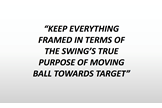Does the swing create the shot, or does the shot create the swing?
Last updated:
What’s the purpose of a golf swing?
This tip comes from TG Top 50 teacher Karl Morris
That sounds like an easy question to answer. But in my experience of working with club players – and indeed touring professionals, right up to Major winners – there are plenty out there who would struggle to deliver the correct answer. A golf swing’s sole purpose is to move the ball from A to B – simple as that.
The better your ability to do this, the better your swing… irrespective of what it looks like. In truth, we all know this… but how rare it is to hear any golfer refer to their swing in these terms. Spend an hour at the range and you will meet plenty of golfers who are ‘working on their swings’.
One is trying to create a fuller shoulder turn; another is working on retaining the lag on the way down. And so it goes, a marvellous variety of technical tweaks all sweated over in the hope that once the move is mastered, the desired shot will come and that wild ball will finally be tamed. The problem with working on your swing like this is that it skews your goal.
Ultimately, we should be targetting improved efficiency at getting the ball from A to B: instead, the goal becomes to have a better swing… and how easily that leads to an unhelpful prioritising of form over function, of style over skill. Let’s look at this question a different way. I spent the day with a Major winner recently. He was struggling with his game.
I asked him this simple question: “Does the swing create the shot, or does the shot create the swing?” He thought about that for a while, then smiled.
“I can’t believe how far down the wrong road I’ve been going the last couple of years,” he eventually admitted. “I’ve been trying to make a perfect move and hope the shot comes out as I wanted it. It rarely has.”
When this golfer began to let the shot create the swing, his whole demeanour changed – as did the flight of his shots. Half an hour later he was hitting low fades and high draws at will, solely through moving his attention away from his swing and onto moving the ball from A to B.
Reframe your game
“That’s all very well,” I hear you say. “But this guy’s an expert. He already has the technique to pull off those shots.”
There is strong evidence to suggest that when you have a clear intention of the shot you are trying to play, your body organises itself around that intention and gravitates instinctively towards the appropriate technique.
However, I do get that argument. If you have a grooved swing path that’s 7º out-to-in, that high draw is probably off the table for you. However, this is no reason for not reframing your approach around moving the ball from A to B… or allowing the shot to create the swing. When you think about it there are nine potential useful shots open to you – draw, straight or fade, high, medium or low.
Now, your current swing might permit only two or three of those; perhaps you feel reasonably adept with a low or medium fade, but struggle with the rest. Now, you might not like that fade or the swing that creates it. But when you see the swing through its true purpose, you begin to see those shots more as acquired skills that allow you to move the ball from A to B. In truth they are what you are good at, not what you are bad at. So instead of heading to the range and attacking your strengths, you can begin to think more in terms of what shots you would like to add.
Ask yourself what shots you’d like to be able to play but can’t. If you want to hit a draw then yes, of course you need to develop the skills to apply the club in a way that hits that shot… and some of that work may be technical. But the point here is to keep everything framed in terms of the golf swing’s true purpose of moving the ball towards a target. This gives your work a purpose, a direction, a clarity that golfers who just work on their swings rarely experience – and will mean your hard work on the range won’t go unrewarded.

